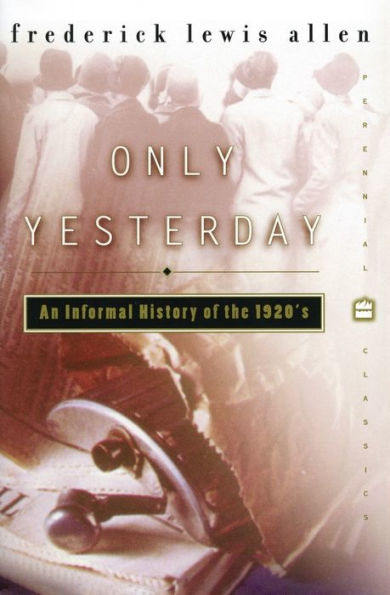Read an Excerpt
Chapter One
Prelude: May, 1919
If time were suddenly to turn back to the earliest days of the Post-war Decade, and you were to look about you, what would seem strange to you? Since 1919 the circumstances of American life have been transformed--yes, but exactly how?
Let us refresh our memories by following a moderately well-to-do young couple of Cleveland or Boston or Seattle or Baltimore--it hardly matters which--through the routine of an ordinary day in May, 1919. (I select that particular date, six months after the Armistice of 1918, because by then the United States had largely succeeded in turning from the ways of war to those of peace, yet the profound alterations wrought by the Post-war Decade had hardly begun to take place.) There is no better way of suggesting what the passage of a few years has done to change you and me and the environment in which we live.
From the appearance of Mr. Smith as he comes to the breakfast table on this May morning in 1919, you would hardly know that you are not in the nineteen-thirties (though you might, perhaps, be struck by the narrowness of his trousers). The movement of men's fashions is glacial. It is different, however, with Mrs. Smith.She comes to breakfast in a suit, the skirt of which--rather tight at the ankles--hangs just six inches from the ground. She has read in Vogue the alarming news that skirts may become even shorter, and that "not since the days of the Bourbons has the woman of fashion been visible so far above the ankle"; but six inches is still the orthodox clearance. She wears low shoes now, for spring has come; but all last winter she protected her ankleseither with spats or with high laced "walking-boots," or with high patent-leather shoes with contrasting buckskin tops. Her stockings are black (or tan, perhaps, if she wears tan shoes); the idea of flesh-colored stockings would appall her. A few minutes ago Mrs. Smith was surrounding herself with an "envelope chemise" and a petticoat; and from the thick ruffles on her undergarments it was apparent that she was not disposed to make herself more boyish in form than ample nature intended.
Mrs. Smith may use powder, but she probably draws the line at paint. Although the use of cosmetics is no longer, in 1919, considered prima facie evidence of a scarlet career, and sophisticated young girls have already begun to apply them with some bravado, most well brought-up women still frown upon rouge. The beauty-parlor industry is in its infancy; there are a dozen hair-dressing parlors for every beauty parlor, and Mrs. Smith has never heard of such dark arts as that of face-lifting. When she puts on her hat to go shopping she will add a veil pinned neatly together behind her head. In the shops she will perhaps buy a bathing-suit for use in the summer; it will consist of an outer tunic of silk or cretonne over a tight knitted undergarment--worn, of course, with long stockings.
Her hair is long, and the idea of a woman ever frequenting a barber shop would never occur to her. If you have forgotten what the general public thought of short hair in those days, listen to the remark of the manager of the Palm Garden in New York when reporters asked him, one night in November, 1918, how he happened to rent his hall for a pro-Bolshevist meeting which had led to a riot. Explaining that a well-dressed woman had come in a fine automobile to make arrangements for the use of the auditorium, he added, "Had we noticed then, as we do now, that she had short hair, we would have refused to rent the hall." In Mrs. Smith's mind, as in that of the manager of the Palm Garden, short-haired women, like long-haired men, are associated with radicalism, if not with free love.
The breakfast to which Mr. and Mrs. Smith sit down may have been arranged with a view to the provision of a sufficient number of calories--they need only to go to Childs' to learn about calories--but in all probability neither of them has ever heard of a vitamin.
As Mr. Smith eats, he opens the morning paper. It is almost certainly not a tabloid, no matter how rudimentary Mr. Smith's journalistic tastes may be: for although Mr. Hearst has already experimented with small-sized picture papers, the first conspicuously successful tabloid is yet to be born. Not until June 26, 1919, will the New York Daily News reach the newsstands, beginning a career that will bring its daily circulation in one year to nearly a quarter of a million, in five years to over four-fifths of a million, and in ten years to the amazing total of over one million three hundred thousand.
Strung across the front page of Mr. Smith's paper are headlines telling of the progress of the American Navy seaplane, the NC-4, on its flight across the Atlantic via the Azores. That flight is the most sensational news story of May, 1919. (Alcock and Brown have not yet crossed the ocean in a single hop; they will do it a few weeks hence, eight long years ahead of Lindbergh.) But there is other news, too: of the Peace Conference at Paris, where the Treaty is now in its later stages of preparation; of the successful oversubscription of the Victory Loan ("Sure, we'll finish the job!" the campaign posters have been shouting); of the arrival of another transport with soldiers from overseas; of the threat of a new strike; of a speech by Mayor Ole Hanson of Seattle denouncing that scourge of the times, the I.W.W.; of the prospects for the passage of the Suffrage Amendment, which it is predicted will enable women. . .



